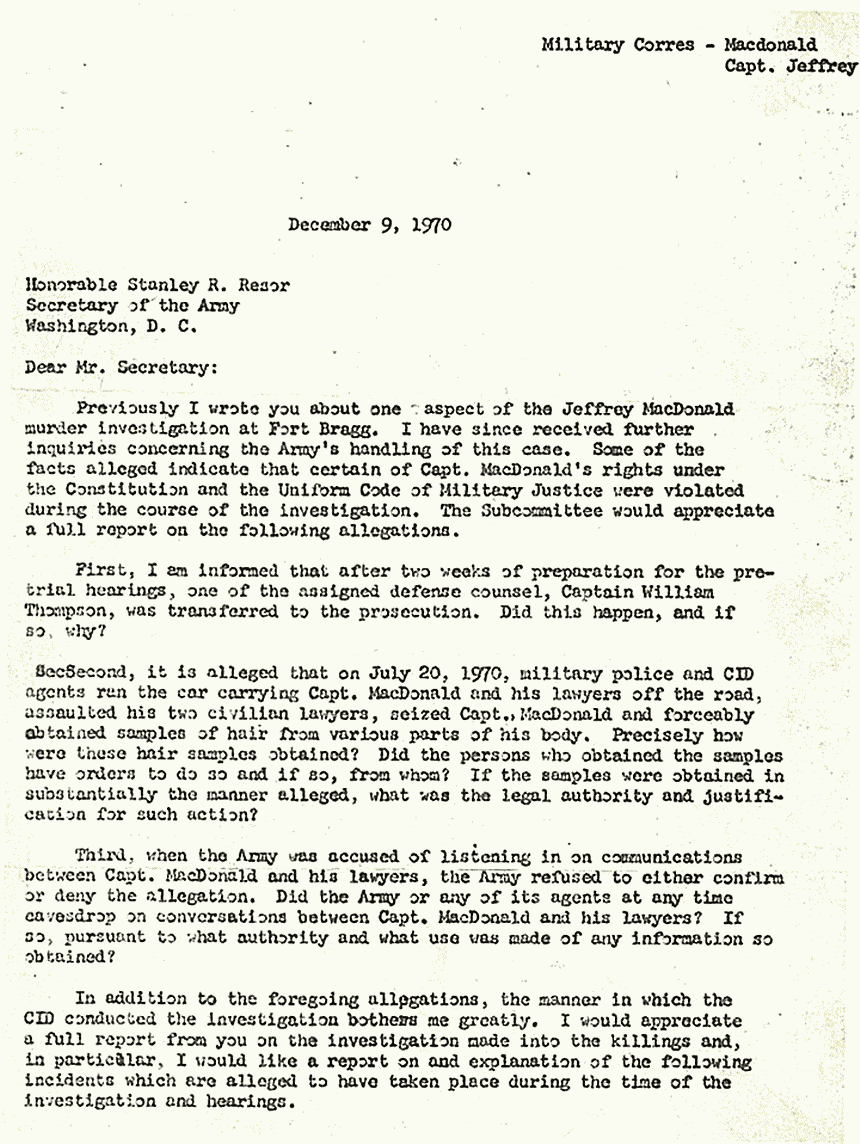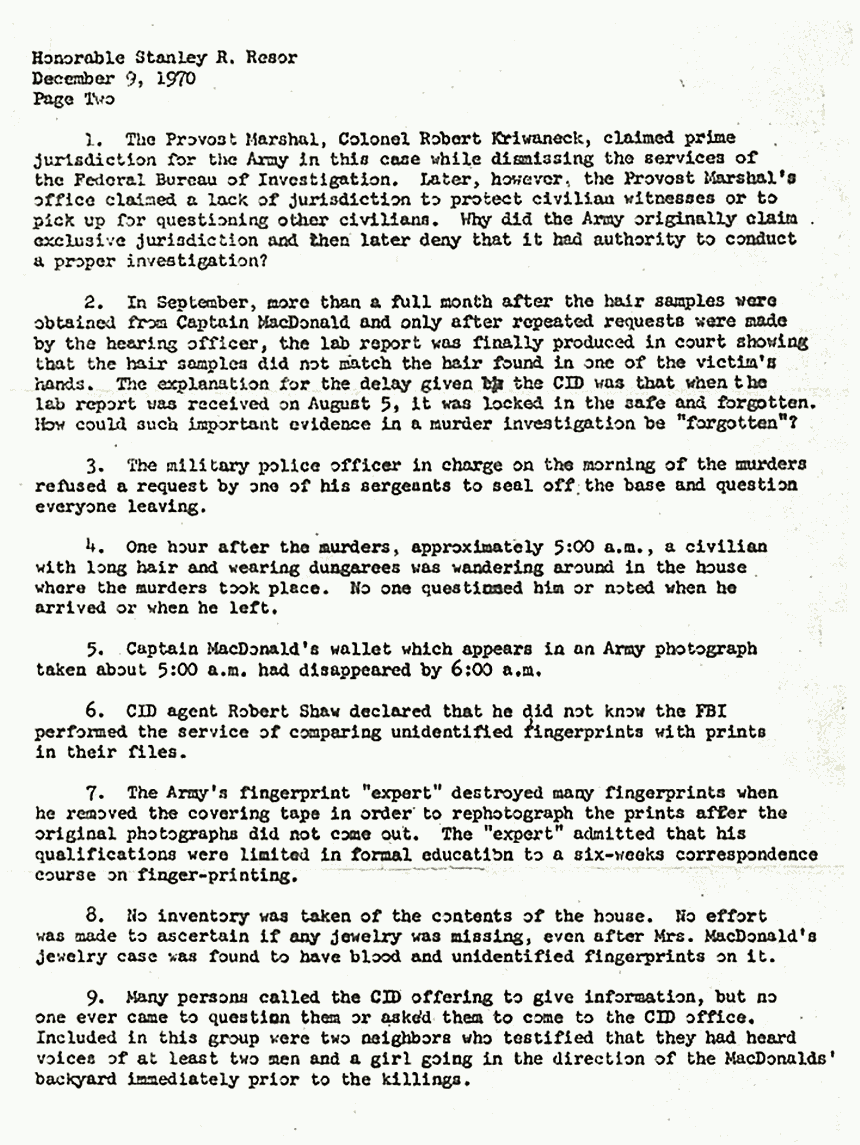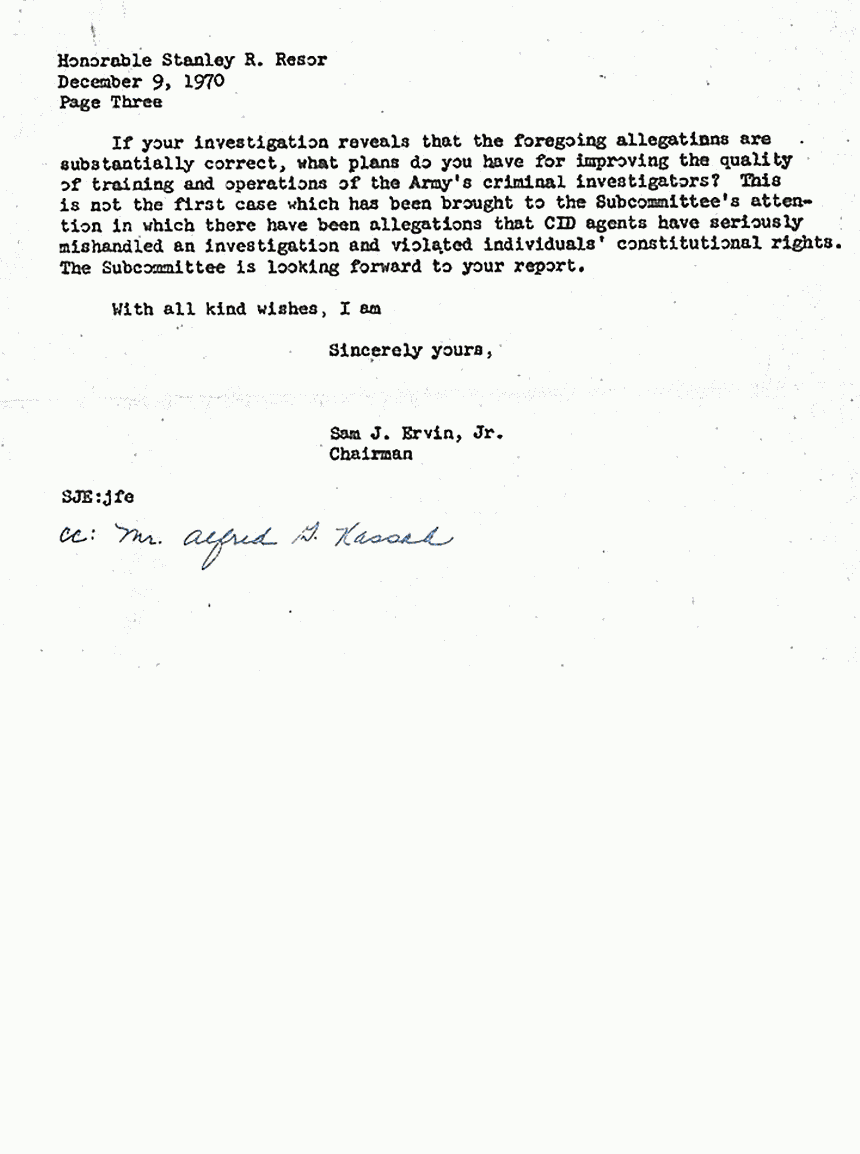CID Records
December 9, 1970
The Kassab-Malley Allegations
Letter of Inquiry from Senator Sam Ervin to Stanley Resor (Secretary of the Army)
Related Files
| SENATOR SAM ERVIN'S INQUIRIES | FINDINGS |
| Did the MP and CID agents stop the car carrying Captain and his civilian lawyers, seize Captain MacDonald and forcibly obtain samples of hair from various part of his body? | Findings: An investigation by the US Army CID Agency revealed that the civilian lawyers were not assaulted by CID agents during the taking of hair samples from Captain MacDonald on July 20, 1970. The report states that Colonel Lennon ordered Captain MacDonald to be apprehended for the purpose of obtaining hair samples from his body. MacDonald was spotted riding on the Fort Bragg military reservation in an automobile containing the defense lawyers, was pursued by military police and CID personnel, and stopped after a short chase. While attempting to block access to the open door of MacDonald's vehicle, lawyer Eisman was set aside by a CID agent and fell to the ground. Preponderance of evidence suggests no excessive force was used by the CID agent to move Eisman. Captain MacDonald was transported to his BOQ. LTC Himma and MSG Dupree took hair samples from Captain MacDonald's body in the presence of Captain Somers, Captain Rainer, and CID agent Hodges. The order to obtain hair samples was issued by government counsel, Captain Somers, on June 3, 1970, and Colonel Lennon issued the pick-up order on July 20, 1970. Defense counsel elected not to be present in the BOQ when hair was taken from MacDonald. |
| Did the Army or any of its agents eavesdrop on the conversations of Captain MacDonald and his lawyers? | Findings: When MacDonald was initially placed under restriction, no private telephone was at his disposal. He used the telephone located in the hallway near the security guard's post. Security guards overheard MacDonald's portion of some calls. Later, a private telephone was installed in MacDonald's room. Colonel Kriwanek directed that tapping and eavesdropping would not be employed in this case. There is no evidence to indicate that electronic surveillance of any form was used during the MacDonald investigation. |
| Did Colonel Kriwanek claim prime jurisdiction for the Army in this case and dismiss the services of the FBI? | Findings: No. FBI SA in charge Murphy, FBI Field Office, Charlotte, NC visited with Colonel Kriwanek and CW3 Grebner a few days after the murders, advising them that the FBI was reducing their investigative support pending the development of any further information which would indicate primary jurisdiction should belong to the FBI. The FBI subsequently sent a letter to LTG Tolson, CG, Fort Bragg, dated February 25, 1970 wherein reasons for the FBI termination of the investigation were enumerated. FBI agent Lacey Walthall, Fayetteville, NC, indicated that the main reason the FBI withdrew from the case was because all physical evidence from the crime scene had been processed by the CID, adding the observation that the FBI considered the case belonged to the Army, not to the FBI. |
| How could the CID "forget" that they had received the laboratory report of hair samples taken from Captain MacDonald? | Findings: CW3 Grebner received the laboratory report of the hair samples on July 30, 1970 and filed it with other laboratory reports. On August 17, 1970 LT Ossman inquired if the hair samples had been received. Grebner told him he could not recall having seen it but, upon checking his files, discovered that it had been received. He immediately notified LT Ossman that he had found the report. Captain Somers was not satisfied with the wording of the report and asked for classification. An addendum was eventually sent by the laboratory and when this was received the report was given to the Article 32 Officer. The control of presentation of the government's case is solely in the hands of government counsel. |
| Did the military police officer in charge on the morning of the murders refuse a request by one of his sergeants to seal off Fort Bragg and question everyone leaving? | Findings: No. Colonel Kriwanek stated that it is not possible to seal Fort Bragg to vehicular traffic without a major, carefully planned effort by several hundred men. Colonel Kriwanek did give an order to the Military Police Desk Sergeant to place all available patrols on the major roads of Fort Bragg and to stop vehicles and check occupants to see if they fit the description of assailants given by Captain MacDonald. None of the post control found any people fitting the description of assailants given by MacDonald. |
| Was a long haired civilian observed wandering around the MacDonald quarters at approximately 0500 February 17, 1970? Was he ever identified? |
Findings: There was no unidentified civilian at the crime scene. The "unknown civilian" was identified as Private James Paulsen, ambulance driver, Womack Army Hospital, Fort Bragg. His hair at that time was longer than the average military cut, and he wore a blue jersey under his Army field jacket. To the casual observer, he could easily have been mistaken for a civilian. He was interviewed by the Inquiry Team. |
| Was Captain MacDonald's wallet stolen? | Findings: Yes. Investigation by USACIDA Inquiry Team revealed that Private James Paulsen stole Captain MacDonald's wallet; removed six one-dollar bills and discarded the wallet in the vicinity of Womack Army Hospital on the morning of February 17, 1970. The wallet was recovered by CID on February 17, 1970, and subsequently returned MacDonald. |
| Did CID agent Shaw declare that he did not know the FBI performed the service of comparing unidentified fingerprints with prints in their files? | Findings: This statement was taken out of context. Shaw's complete statement was, "I am not aware that the FBI performs this service; in fact I know they do not." The FBI cannot conduct a search of its main fingerprint file for the purpose of identifying a single latent print unless it has: (a) all ten fingerprints of the subject or (b) possesses a name and identification data of the person suspected of having made the fingerprint impression. |
| Did the Army's fingerprint expert destroy many fingerprints when he removed the covering tape in order to re photograph the prints after the original photographs did not come out? | Findings: Eighty-seven latent fingerprints in the MacDonald quarters were photographed, then clear plastic tape was placed over the latent prints in order to preserve them. When the pictures were developed, seven exposures were of such poor quality that they prevented clear identification. It was necessary to re-photograph the seven prints. However, in the meantime, dusting powder had adhered to the protective tape, thus distorting some of the characteristics of the latent prints. They could not be further identified. |
| Did the Army's fingerprint expert admit that his qualifications were limited to a six-week correspondence course on fingerprinting? | Findings: During the Article 32 hearing, MSG Medlin offered the following qualifications: He was assigned to the Criminal Investigation Laboratory in October 1963, attended the eight-week Criminal Investigation course, trained for two years under the guidance of a fully qualified fingerprint technician and has been a fingerprint examiner since 1965. MSG Medlin completed the Institute of Applied Sciences Fingerprint correspondence course in 1957. Medlin is a qualified fingerprint expert and has been an expert in numerous other judicial proceedings. Medlin presented a paper to the annual conference of the International Association for Identification in 1967, and he had articles published in other professional magazines. |
| Was an inventory taken of the contents of the MacDonald quarters? | Findings: No. Items of evidentiary were inventoried, but no complete inventory of the contents of the quarters was made. According to Colonel Lennon, a complete inventory was not necessary. Except for MacDonald's TV and other items which MacDonald requested the CID to obtain for his BOQ, nothing in the house was disturbed, except items sent to Fort Gordon Laboratory for analysis. An inventory of these items were maintained. |
| Was an effort made to ascertain if jewelry was missing, even after the jewelry case was found to have blood and unidentified fingerprints on it? | Findings: No evidence exists to support the claim that jewelry was stolen. No latent prints appear on the exterior of the jewelry box, and of the prints inside the box, one has been positively identified as being made by Captain MacDonald. The other is a partial print that reveals only a few ridges and has not been identified. It could have been made by Mrs. MacDonald. Unfortunately, no record exits of full rolled impressions of Mrs. MacDonald's fingers and palms, thus obviating a comparison in this case. The stains on the jewelry box were determined to be organic substance, not blood. Whether or not heirloom rings were stolen is known to Kassab and MacDonald alone. |
| Did the CID fail to follow up leads? Specifically, did the CID fail to interview two neighbors who heard voices of two males and a female going in the direction of the MacDonald backyard immediately prior to the killings? | Findings: There are no indications that the CID failed to explore substantive leads. The publicity generated many calls and letters, some were helpful and others useless. It appears that an honest attempt was made to follow-up all useful leads. The FBI and CID interviewed 39 neighbors of the MacDonalds in an attempt to determine if anyone heard or saw suspicious actions on the morning of February 17, 1970. This extensive investigation included interviews with persons who heard voices outside their quarters. Each lead was pursued diligently. |



